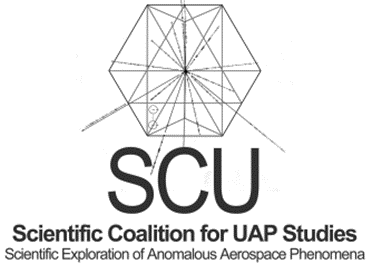
SCU Study Identifies the Evolving Patterns of Activity by Unidentified Anomalous Phenomena (UAP)

The new paper is the fourth in a series investigating post-World War II UAP activities
WASHINGTON, DC, UNITED STATES, May 21, 2025 /EINPresswire.com/ -- A new, peer-reviewed study by the Scientific Coalition for UAP Studies (SCU) of Unidentified Anomalous Phenomena (UAP) activities between 1945 and 1975 shows a shift toward nighttime activities. It suggests possible human behavioral studies by the UAP.
The study, “UAP Indications Analysis 1945-1975 Military and Public Activities,” supports the conclusion that these phenomena are intelligent actors possessing advanced technology.
Authored by SCU members Larry J. Hancock, Ian M. Porritt, Sean Grosvenor, Larry Cates, and Joshua Pierson, this in-depth analysis examines patterns of UAP behavior, offering valuable insights into potential UAP intentions.
Key findings of the study:
1. Initial Atomic Weapons Focus: UAP activities showed a consistent interest in key developments and deployments in military atomic warfare facilities. They showed early interest in radioactive materials plants, the atomic weapons assembly facilities, and the atomic weapons stockpile sites in the late 1940s. In later years, they showed interest in the Intercontinental ballistic missiles (ICBM) and other atomic deployment sites. The most notable of these incidents was the 1967 Malmstrom event where a UAP disabled multiple missile silos and a cluster of activity over 24 days during October to November 1975 involving the northern atomic warfare sites of Malmstrom, Minot, Wurtsmith and Loring.
2. Transition in Activities: Early UAP activities (1945-1964) were characterized by high visibility and potential inferential messaging (messaging via their actions rather than through communication), with some limited contact efforts in the late 1950s, followed by a significant shift to nighttime activities involving possible human behavioral studies by the 1970s.
3. Recognition and Contact: During the earliest period, UAP activities were overt and often involved display-type activities with close approaches involving radical flight characteristics and interactive flight (UAP operating in formations). Following this period, display-type activities started to decrease. However, the authors identified a limited number of electronic transmissions by UAP, particularly in 1957, with Identification Friend or Foe (IFF) coded transmissions by UAP, suggesting limited communication efforts.
4. Behavioral Studies: Later years saw a shift in UAP activities towards longer observations by witnesses, close UAP approaches to small groups of observers, and UAP actions that could be interpreted as basic human behavioral studies rather than contact efforts.
5. UAP Activity Progression: UAP activities became more clandestine over time, with an increasingly negative perception by witnesses of their behavior.
Intentions Study team member Ian Porritt notes that pattern analysis provides valuable insights into the behavior of UAPs.
“Based on identification and recognition activities, which could be considered inferential messaging, and the incidents involving IFF signals where UAP responded with coded responses,” co-author Ian M. Porritt said. “This early period could be considered part of an initial contact protocol.”
However, instead of progressing to overt contact and increased communication attempts as expected with a standard protocol, the study reveals a shift in their behavior from overt recognition activities to clandestine nighttime interactions with the public.
“This insight into the change in UAP behavior will be a crucial part in understanding future interactions, deciphering intentions, and possibly understanding their origins," Porritt said.
This study is the fourth in a series of examinations of UAP activity in the post-World War II era that provides valuable insights into the evolving intentions of UAP over the three-decade study period.
SCU’s first study, UAP Pattern Recognition Study: 1945-1975 US Military Atomic Warfare Complex, revealed bursts of reports of anomalous UAP activity at sites where new capabilities were being developed and deployed, a pattern researchers have not considered in previous government or university studies of UAP reports.
The second study, UAP Indications Analysis 1945-1975, United States Atomic Warfare Complex, examined scenarios related to intention and motive indicated by specific details of reported UAP activity. The study found the best estimate of the situation was a focused survey of atomic weapons/warfighting capability.
The third study, UAP Activity Pattern Study 1945-1975 Military and Public Activities, revealed a change in UAP activities over time. We see a shift from a majority of daytime incidents early on to predominantly nighttime, and a shift from 'display type' activities (interactive flight, and radical flight) in the earlier years to nighttime close approaches to the public later. During this transition period, we see a cluster of electronic transmissions.
Read the study online, or download the paper and associated data, here: https://zenodo.org/records/14647871
About SCU:
SCU promotes and encourages the rigorous scientific examination of UAP, commonly known as Unidentified Flying Objects (UFOs). SCU comprises scientists, engineers, members of the high-tech and defense industries, former military, and other professionals, utilizing scientific principles, methodologies, and practices to advance the study of UAP observed and reported around the globe.
The Scientific Coalition for UAP Studies is a 501(c)(3) charitable organization. Contributions to SCU are tax-deductible.
###
Kevin A Wright
Solve Advocacy
+1 703-965-3559
email us here
Visit us on social media:
LinkedIn
X
Distribution channels: Aviation & Aerospace Industry, Military Industry, Science, U.S. Politics, World & Regional
Legal Disclaimer:
EIN Presswire provides this news content "as is" without warranty of any kind. We do not accept any responsibility or liability for the accuracy, content, images, videos, licenses, completeness, legality, or reliability of the information contained in this article. If you have any complaints or copyright issues related to this article, kindly contact the author above.
Submit your press release